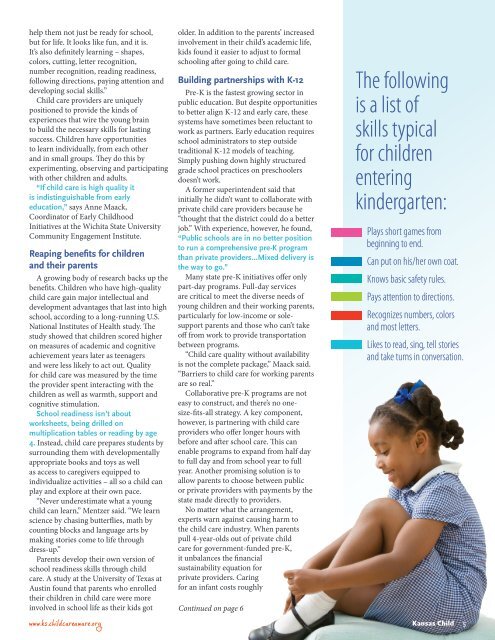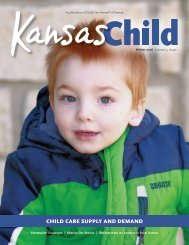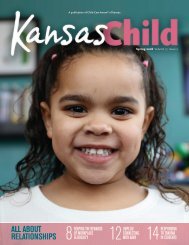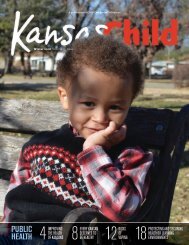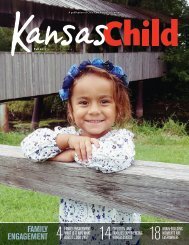2018 Summer Kansas Child
School Readiness
School Readiness
Create successful ePaper yourself
Turn your PDF publications into a flip-book with our unique Google optimized e-Paper software.
help them not just be ready for school,<br />
but for life. It looks like fun, and it is.<br />
It’s also definitely learning – shapes,<br />
colors, cutting, letter recognition,<br />
number recognition, reading readiness,<br />
following directions, paying attention and<br />
developing social skills.”<br />
<strong>Child</strong> care providers are uniquely<br />
positioned to provide the kinds of<br />
experiences that wire the young brain<br />
to build the necessary skills for lasting<br />
success. <strong>Child</strong>ren have opportunities<br />
to learn individually, from each other<br />
and in small groups. They do this by<br />
experimenting, observing and participating<br />
with other children and adults.<br />
“If child care is high quality it<br />
is indistinguishable from early<br />
education,” says Anne Maack,<br />
Coordinator of Early <strong>Child</strong>hood<br />
Initiatives at the Wichita State University<br />
Community Engagement Institute.<br />
Reaping benefits for children<br />
and their parents<br />
A growing body of research backs up the<br />
benefits. <strong>Child</strong>ren who have high-quality<br />
child care gain major intellectual and<br />
development advantages that last into high<br />
school, according to a long-running U.S.<br />
National Institutes of Health study. The<br />
study showed that children scored higher<br />
on measures of academic and cognitive<br />
achievement years later as teenagers<br />
and were less likely to act out. Quality<br />
for child care was measured by the time<br />
the provider spent interacting with the<br />
children as well as warmth, support and<br />
cognitive stimulation.<br />
School readiness isn’t about<br />
worksheets, being drilled on<br />
multiplication tables or reading by age<br />
4. Instead, child care prepares students by<br />
surrounding them with developmentally<br />
appropriate books and toys as well<br />
as access to caregivers equipped to<br />
individualize activities – all so a child can<br />
play and explore at their own pace.<br />
“Never underestimate what a young<br />
child can learn,” Mentzer said. “We learn<br />
science by chasing butterflies, math by<br />
counting blocks and language arts by<br />
making stories come to life through<br />
dress-up.”<br />
Parents develop their own version of<br />
school readiness skills through child<br />
care. A study at the University of Texas at<br />
Austin found that parents who enrolled<br />
their children in child care were more<br />
involved in school life as their kids got<br />
older. In addition to the parents’ increased<br />
involvement in their child’s academic life,<br />
kids found it easier to adjust to formal<br />
schooling after going to child care.<br />
Building partnerships with K-12<br />
Pre-K is the fastest growing sector in<br />
public education. But despite opportunities<br />
to better align K-12 and early care, these<br />
systems have sometimes been reluctant to<br />
work as partners. Early education requires<br />
school administrators to step outside<br />
traditional K-12 models of teaching.<br />
Simply pushing down highly structured<br />
grade school practices on preschoolers<br />
doesn’t work.<br />
A former superintendent said that<br />
initially he didn’t want to collaborate with<br />
private child care providers because he<br />
“thought that the district could do a better<br />
job.” With experience, however, he found,<br />
“Public schools are in no better position<br />
to run a comprehensive pre-K program<br />
than private providers…Mixed delivery is<br />
the way to go.”<br />
Many state pre-K initiatives offer only<br />
part-day programs. Full-day services<br />
are critical to meet the diverse needs of<br />
young children and their working parents,<br />
particularly for low-income or solesupport<br />
parents and those who can’t take<br />
off from work to provide transportation<br />
between programs.<br />
“<strong>Child</strong> care quality without availability<br />
is not the complete package,” Maack said.<br />
“Barriers to child care for working parents<br />
are so real.”<br />
Collaborative pre-K programs are not<br />
easy to construct, and there’s no onesize-fits-all<br />
strategy. A key component,<br />
however, is partnering with child care<br />
providers who offer longer hours with<br />
before and after school care. This can<br />
enable programs to expand from half day<br />
to full day and from school year to full<br />
year. Another promising solution is to<br />
allow parents to choose between public<br />
or private providers with payments by the<br />
state made directly to providers.<br />
No matter what the arrangement,<br />
experts warn against causing harm to<br />
the child care industry. When parents<br />
pull 4-year-olds out of private child<br />
care for government-funded pre-K,<br />
it unbalances the financial<br />
sustainability equation for<br />
private providers. Caring<br />
for an infant costs roughly<br />
Continued on page 6<br />
The following<br />
is a list of<br />
skills typical<br />
for children<br />
entering<br />
kindergarten:<br />
•§<br />
Plays short games from<br />
beginning to end.<br />
•§<br />
Can put on his/her own coat.<br />
•§<br />
Knows basic safety rules.<br />
•§<br />
Pays attention to directions.<br />
•§<br />
Recognizes numbers, colors<br />
and most letters.<br />
•§<br />
Likes to read, sing, tell stories<br />
and take turns in conversation.<br />
www.ks.childcareaware.org <strong>Kansas</strong> <strong>Child</strong> 5


